| << Chapter < Page | Chapter >> Page > |
In this case, there are finite initial horizontal and vertical separations. For collision to occur, projectiles need to cover these separations simultaneously. Clearly, component relative velocity in x and y directions are finitie. We can obtain time of collision by consideration of relative motion in either direction,
or
Problem : Two projectiles are projected simultaneously from two towers as shown in the figure. If the projectiles collide in the air, then find the distance “s” between the towers.
Relative motion
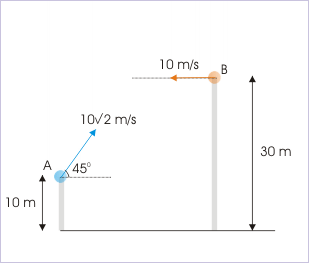
Solution : We see here that projectiles are approaching both horizontally and vertically. Their movement in two component directions should be synchronized so that they are at the same position at a particular given time. For collision, the necessary requirement is that relative velocity and displacement should be in the same direction.
It is given that collision does occur. It means that two projectiles should cover the displacement with relative velocity in each of the component directions.
Relative motion
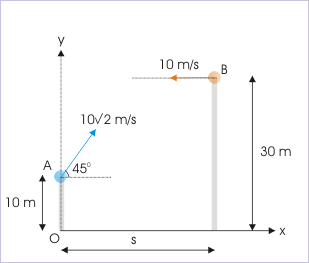
In x-direction,
If “t” is time after which collision occurs, then
Clearly, we need to know “t” to find “s”. The component of relative velocity in y-direction is :
The initial vertical distance between points of projection is 30-10 = 20 m. This vertical distance is covered with component of relative velocity in vertical direction. Hence, time taken to collide, “t”, is :
Putting this value in the earlier equation for “s”, we have :
Two projectiles are projected simultaneously from two towers as shown in the figure. If collision takes place in the air, then what should be the ratio "x/y" :
Relative motion of projectiles
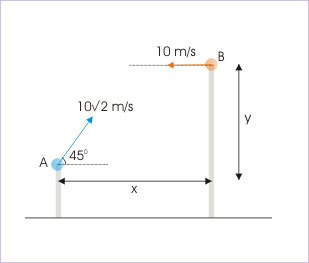
According to question, collision occurs in the mid air. The necessary condition for collision is that direction of relative velocity and initial displacement between projectiles should be same.
In x-direction,
In y-direction,
The angle that relative velocity makes with horizontal is :
This is also the slope of displacement AB,
Hence, option (c) is correct.
Two balls are projected simultaneously with speeds " ” and “" ” from two points "O" and "A" respectively as shown in the figure. If the balls collide, then find the ratio " ” (consider g = 10 ) :
Relative motion of projectiles
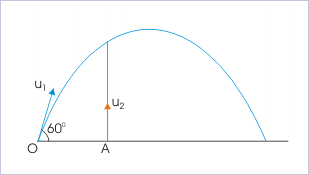
It is given that the projectiles collide. Now the initial separation in vertical direction is zero. It follows then that component of relative velocity between two projectiles in vertical direction should be zero for collision to take place. This is possible if the vertical component of velocity of projectile form "O" is equal to the speed of projectile form "A" (Remember that acceleration due to gravity applies to both projectiles and relative acceleration in vertical direction is zero).
Hence, option (a) is correct.
Two projectiles “A” and “B” are projected simultaneously towards each other as shown in the figure. Determine if they collide.
Relative motion
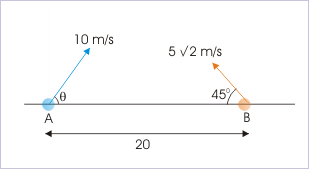
There is no separation in vertical direction at the start of motion. As such, relative velocity in y-direction should be zero for collision to occur.
Relative motion
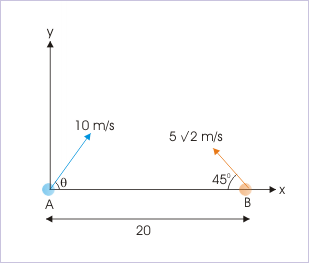
In the x-direction, the initial separation is 15 m and the relative velocity is :
The time after which collision may occur is :
We should, however, check whether projectiles stay that long in the air in the first place? Now, we have seen that the projectiles should have same vertical component of velocity for collision to occur. As time of flight is a function of vertical component of velocity, the time of the flight of the projectiles are equal. For projectile “A” :
This means that projectiles would not stay that long in the air even though the necessary conditions (but not sufficient conditions) for the collision are fulfilled. Clearly, collision does not occur in this case. We should clearly understand that "analysis of motion with respect to collision" and "requirements of collision" are not same. In this module, we have studied the "consequence of collision" - not the "conditions for collision".

Notification Switch
Would you like to follow the 'Physics for k-12' conversation and receive update notifications?